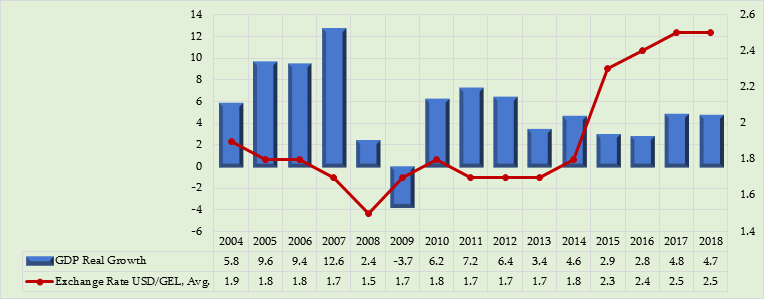Resume: Under the United National Movement’s rule, Georgia’s economy (real GDP) grew by an annual average of 6.2%. The period after the change of government witnessed a slowing down of the economic growth rate with the economy growing by an average of 3.9% annually from 2013 to 2018. The economic growth rate was 6.4% in 2012, 3.4% in 2013 and 4.7% in 2018. There are several factors which stipulate the slowing down of the economic growth rate and part of these factors are beyond the Government of Georgia’s reach. For instance, one such factor is less stability in the region and in the world. The Russia-Ukraine conflict as well as developments in Syria and Turkey have turned out to be especially harmful in this regard. However, the Government of Georgia is responsible for a number of factors accounting for the slow economic growth because of haphazard reforms such as: the stricter visa policy, banning the sale of land to foreigners and demonstrating inconsistent policies vis-à-vis investors, halting/cancelling infrastructural projects, etc.
In 2004-2012, the average GEL to USD exchange rate was 1.7 whilst it was 2.2 in 2013-2018. As of current data for 2019, the GEL exchange rate against USD depreciated by nearly 65% as compared to October 2012. The sharp depreciation of GEL started in 2014. However, in this case, too, the GEL exchange rate was affected by external factors such as the strengthening of the dollar index. On the other hand, however, those steps taken by the Government of Georgia which we mentioned whilst talking about the GDP growth, have affected the GEL exchange rate.
Georgian Dream members did indeed make statements during the 2012 election campaign period about “unjustifiably high” utility tariffs and the possibility to sharply reduce them. Since 2012 up until the present day, electricity consumer tariffs have increased by 0.04-0.05 GEL, let alone being halved. In the case of natural gas, consumer tariffs were unchanged before 2017 but they were subsidised by GEL 0.05 which technically cannot be considered as a lowering of the consumer tariff. These subsidies ended in 2017. In 2017, the natural gas tariff was increased for part of the population living in the regions because the Georgian National Energy and Water Supply Regulatory Commission (GNERC) imposed a single tariff for SOCAR Georgia Gas. The company encompasses 41 former gas supply license holders and, therefore, prior to GNERC’s decision, different consumer tariffs were applied for different regions and cities. This means that SOCAR Georgia Gas customers had their tariffs increased in different proportions. Some customers even had their tariffs increased by GEL 0.26.
Analysis
On 21 May 2019, on air on the talk show, Archevani, European Georgia – Movement for Freedom MP, Otar Kakhidze, stated (from 57:40): “Billionaire Ivanishvili and his government even failed to keep what they inherited – to keep the economic growth rate and the GEL exchange and at least keep those tariffs which he promised to halve.”
To start, it is important to take a look at the GDP growth and the GEL exchange rate dynamics.
Graph 1: GDP Growth and GEL Exchange Rate Dynamics

Source: National Statistics Office of Georgia
Under the United National Movement’s rule, Georgia’s economy (real GDP) grew by an average of 6.2% annually. The period after the change of government witnessed a slowing down of the economic growth rate with the economy growing by an average of 3.9% annually from 2013 to 2018. The economic growth rate was 6.4% in 2012, 3.4% in 2013 and 4.7% in 2018. There are several factors which stipulate the slowing down of the economic growth rate and a part of these factors are beyond the Government of Georgia’s reach. For instance, one such factor is less stability in the region and in the world. The Russia-Ukraine conflict as well as developments in Syria and Turkey have turned out to be especially harmful in this regard. However, the Government of Georgia is responsible for a number of factors accounting for the slow economic growth because of haphazard reforms such as: the stricter visa policy, banning the sale of land to foreigners and demonstrating inconsistent policies vis-à-vis investors, halting/cancelling infrastructural projects, etc (see link 1, link 2 and link 3).
In 2004-2012, the average GEL to USD exchange rate was 1.7 whilst it was 2.2 in 2013 to 2018. As of the current data for 2019, the GEL exchange rate against USD depreciated by nearly 65% as compared to October 2012. The sharp depreciation of GEL started in 2014. However, similar to the GDP, only part of the factors affecting the GEL exchange rate is within the reach of the Government of Georgia. A significant factor over which the Government of Georgia does not have a control mechanism is the dollar index which started to strengthen rapidly from the third quarter of 2014 as well as economic and political problems in the region. The Government of Georgia has its share of responsibility and their certain actions[1] and inactions negatively affect the GEL exchange rate.
Georgian Dream members did indeed make statements during the 2012 election campaign period about “unjustifiably high” utility tariffs and the possibility to sharply reduce them.
In accordance with Georgia’s Legislative Herald’s data, electricity consumer tariffs have increased by 0.04-0.05 GEL, let alone being halved, since 2012 to the present day.
Table 1: Changes in Electricity Consumer Tariff in 2010-2017 (Tetri/Kwth excluding VAT)
|
TELASI |
2010 |
Dec. 2012 |
Apr. 2013 |
Sep. 2015 |
Dec. 2016 |
Dec. 2017 |
|
0–101 Kwt/h |
11.424 |
8.424 |
11.424 |
11 |
11 |
12.325 |
|
101–301 Kwt/h |
13.56 |
10.56 |
13.56 |
14.4 |
14.4 |
15.725 |
|
301 Kwt/h and more |
14.998 |
14.998 |
14.998 |
18.2 |
18.2 |
19.525 |
|
ENERGOPRO |
2010 |
Dec. 2012 |
Apr. 2013 |
Sept. 2015 |
Dec. 2016 |
Dec 2017 |
|
0–101 Kwt/h |
11 |
8 |
7.63 |
7.63 |
10.978 |
12.065 |
|
101–301 Kwt/h |
14 |
11 |
11 |
11 |
14.348 |
15.435 |
|
301 Kwt/h and more |
14.83 |
14.83 |
14.83 |
14.83 |
18.178 |
19.265 |
In regard to natural gas tariffs, the three largest suppliers each have different consumer tariffs. For KazTransGaz customers, the upper margin of the consumer tariff was not changed in 2012-2017 although a GEL 0.05 reduction in tariffs came at the expense of subsidy in March 2013 which was largely a political decision. The natural gas tariff decreased at the expense of the earnings of the Georgian Oil and Gas Corporation. The Georgian Oil and Gas Corporation has reduced its supply price for distribution companies. In July 2017, subsidy memorandums were repealed, putting an end to that practice. In the same July 2017, natural gas tariffs increased for people living in the regions because GNERC imposed a single tariff - GEL 0.4825 excluding VAT - for SOCAR Georgia Gas. See FactCheck’s research on this topic here.
Table 2: Natural Gas Consumer Tariffs Excluding VAT in 2012-2018
|
Organisation |
August 2012- July 2017 |
July 2017-2018 |
|
|
KazTransGaz |
High Pressure |
31.669 |
39,113 |
|
Medium Pressure |
34.805 |
||
|
Low Pressure |
42.898 |
||
|
SOCAR |
- |
48.254 |
|
|
Sakorggas |
48.314 |
||
Source: Georgia’s Legislative Herald
[1] In 2016, there was the idea to separate supervisory functions from the National Bank of Georgia, the introduction of a stricter visa policy, unequal spending of state finances, etc.








